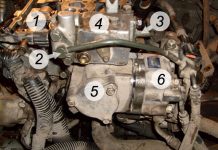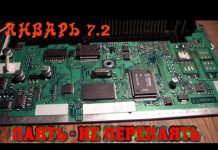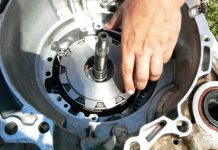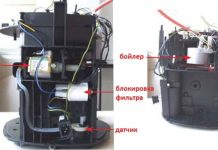So the train is not ripped out, you need to remove the clamping bar immediately.
Of course they do not tear it out, I pushed the bar aside after I removed the plastic, but I do not repent of it in the video. Plus for being attentive. The magnet is available, but the twin gear that the magnet tongues is blocking is not. In addition, it is problematic to show everything clearly without removing the gearbox. But in general, thanks for the criticism 🙂
I hope the author was shot after the disassembly.
Thank you very much for your help, your video helped our family a lot in repairing the printer
I have a Canon MP 250 printer and after repair it hangs the paint in the tube and it does not reach the cartridge as I have a CISS. Why might this be happening?
Hello! I made the first refueling on lbp 2900b on my own, after that it seems to work the same way, but the paper rolls out the same clean without printing. I read about some kind of chip on the forums. Tell me what is the problem?
Forget the chip. Disassemble the cartridge and check the magnetic shaft spring.
Hello! I have lbp 2900b. Fault: when printing in the center of the sheet, it smears the text, and after the first sheet, the second gets stuck. What could it be?
it was a problem with the rubber shaft in the stove, the rubber on the shaft peeled off from the metal rod, and because of this, the rod would spin without the rubber sheath.
Hello! I have lbp 2900. Problem: after each printed sheet there is a pause of 10-20 seconds. What could it be?
Thermal film breaks more often, but this also happens.
The problem is not with the printer, but with your software, hardware, or USB cable.
Definitely, software and not a cord, tk. other printers work on them.
And THIS printer on a different PC and with a different cable, how does it behave?
VIDEO
Important : Trade names, logos or company marks mentioned directly or indirectly on the website belong to these companies and are used only for the purpose of identifying the products of these companies. The main task of the project is to create guides for the elimination of certain problems. Whether or not to change the factory characteristics of the device is only your decision. I am not responsible for damages, direct or indirect, caused by any of your actions. You should be aware that an attempt to flash the device, refill a cartridge or repair the device yourself will void all warranty obligations to you from the device manufacturer.
Thermal film is one of the most commonly worn parts. It is located in the fusing unit (oven) and acts as an intermediary between the sheet of paper and the heating element. Replacement of thermal film is made in case of wear or damage. The wear of the thermal film is indicated by uneven rough streaks along the edges of the sheet. Also, often, if the thermal film is damaged, a characteristic rustle is heard at the place where the paper comes out of the stove, and paper jams in the fixing unit.
In order to replace the thermal film, you must disassemble the printer and remove the fusing unit from it.
Parsing the device:
Remove the side, back, front and top covers of the printer.
Disconnect the connectors of the wires leading to the stove.
Unscrew the three screws and remove the fusing unit.
Dismantling the stove and replacing the thermal film:
We remove the springs pressing the thermal film to the rubber shaft.
We remove the old thermal tape.
We clean the heating element from the accumulated toner.
Apply an even layer of thermal grease to the heating element.It is advisable to use an original thermal grease, manufactured by HP or Canon.
We put on a new thermal film on the heating element. We collect the stove and install it in the printer.
Also, often together with the thermal film, it is necessary to change the pressure rubber shaft and bearings.
START COPY CONFERENCE
Good day!
Is voltage applied to the solenoid at the start of printing, at the time the tray is lifted?
DenVut (0): roller is spinning which roller is spinning?
Only 2.5V is supplied to the solenoid, apparently this is not enough for it to operate.
I tried to disconnect the solenoid from the board and supply 12V, everything works fine. Accordingly, as soon as it worked, the gear is released and the paper is lifted.
Maybe look at the formatter board, do not disappear?
Or maybe pick up a tester and see that the roads to the solenoid go through the formatting board? Maybe you will get to the transistor on RM1-3412
Connector J910 Flat cable for Formatter board
actually there is 24 volts, not 12
I got to the transitor, changed it. Now 24V appears on the connector, but there is no ground. At the same time, apparently, “+” goes there constantly when turned on, but everything is controlled through the transistor “-“, because exactly the “-” track goes to the transistor.
24V has nothing to do with the transistor
And where to dig further? Even if I solder the old one in place.
Sorry, but poke my head where to look: (((there are 3 transistors. To which to attach?
(13) Top right. The solenoid is connected in parallel with the diode (for 1 and 3).
The article discusses the method of disassembling the "Canon LBP3000" laser printer, some features of the device's prophylaxis, as well as the replacement of its assemblies and parts.
Warning. The author is not responsible for possible negative consequences when performing repairs or carrying out maintenance work, therefore, if you are not sure of your abilities, contact the specialists.
General information and required tools
Laser printers "Canon LBP2900 / 3000" refers to devices for home and small office. The maximum monochrome printing speed is 12/14 cpm with a resolution of 600 600 dpi.
It uses a USB 2.0 interface to connect to a computer. The printer uses a Canon 703 cartridge with a manufacturer's declared yield of 2,000 A4 pages (at 5% coverage). On the control panel of the printer there are “Power” and “Paper” paper presence / jam indicators combined with the “Paper” button. The "Paper" indicator blinks when the paper is loaded or out of paper in the tray, and the button is used to restart printing on the printer after the cause of the blinking is eliminated. There are no other hardware buttons (except for the Power key and the Paper button) in the device - the printer is controlled from the computer.
The description of disassembly, maintenance and replacement of units in the article will be considered on the example of the printer "Canon LBP3000", on the printer "Canon LBP2900" the work is carried out in the same way.
Maintenance work includes cleaning the printer components from dust and toner, as well as, if necessary, replacing the lubricant on the device components and the thermal lubricant under the thermal film in the fusing unit. The required degree of disassembly of the apparatus is determined by the set of operations performed.If there is no contamination and the unit is functioning normally, it should not be disassembled.
Repair work begins with cleaning the device from contamination (if necessary), external inspection of elements and assemblies, checking for contact in the connectors and checking the operation of the device's sensors.
To perform disassembly, repair and maintenance work, the following tools are required:
1. Flat screwdriver - 2 pcs. (blade width 3 and 5 mm).
6. Brush 2 pcs. (soft and hard).
7. Vacuum cleaner for toner (if it is necessary to clean the components of the device from toner and dust).
You may also need consumables (thermal grease, thermal paste, conductive grease, liquid and grease lubricants, acetone, alcohol, etc.) and spare parts, depending on the work performed on the device.
Removing the covers from the device
1. Place the printer with the front facing you. Raise the near side of the printer and put a rail (wooden block, etc.) with a thickness of 1-2 cm. Set the feed tray to the working position. Press on the middle of the tray along the line of the axis of rotation, press the tray to the right and remove the left axis from the landing in the front cover (1 in Fig. 1), then move it to the left, remove the right axis from the landing (2) and remove the tray from the device.
2. Remove the output tray. To remove, raise the middle of the tray on the line of the axis of rotation upwards, and, simultaneously pressing it to the right, remove the left axis (1 in Fig. 2) from the landing in the front cover.
The full article can be read in the paper version of the magazine
Soldier
Group: Members
Expert
Group: Admin
Expert
Group: Admin
Soldier
Group: Members
Expert
Group: Admin
What exactly is being launched? After all, I specifically asked to describe in more detail.
If, when turned on with the engine, it scrolls and comes out on readiness, and when sending for printing, the engine scrolls and goes into a jam with the engine (due to the fact that the feed roller is not spinning), then first of all look at the connector on the formatter board from the solenoid. After all, the wires to the solenoid go through it in transit. Was the formatter board not turned off at all?
Soldier
Group: Members
Expert
Group: Admin
Then look for the solenoid control “key” on the mechanism controller board (the one with the laser unit). Ring the entire line from the board to the solenoid.
And yet, be sure to ring the stove (even do it first). It does not need to be removed, and the current connector with thick wires should be disconnected from the power board and tinkled directly from the connector. Should be about 100 ohms. Announce the results of the dialing.
Repair mfp printer CANON LBP2900
CANON LBP2900 printer service and repair in Moscow and the region.
Repair of the CANON LBP2900 printer
CANON LBP2900 Printer Broken?
Unscrew the two self-tapping screws from the side of the drum gear.
By tilting the cartridge upwards with the hopper and pushing the plastic part of the housing away from the drum gear side, turning it, take out the drum unit. Release the gear from the cartridge and pull the drum unit towards the gear.
When removing the drum unit, the cartridge must be held down with the waste bin, otherwise toner will spill out.
Wet the cloth with a special drum cleaner and polish cleaner.
Use a napkin to remove toner residues from the drum unit.
In cases where a carbonized layer of toner has formed on the drum unit, you must use a special cleaner for stubborn dirt on the drum unit.
After cleaning and polishing the drum unit, place it in a black bag or in a dark place.
We remove the primary charge shaft.
Apply a special shaft cleaner to the napkin. 12.Carefully wipe the shaft from the plaque that forms during operation
Using a rather long metal pin, we get to the metal sleeve fixing both halves of the cartridge from the inside.
Using a small hammer, knock the sleeve out. It is enough to knock out 2-3mm.
15. Do the same with the other bushing on the other side of the cartridge.
16. The pin must be kept as close to the cartridge as possible.
17. Using pliers, remove the sleeve from the outside, holding the cartridge with your hand together.
We remove the second sleeve. Remember - you need to hold the cartridge down with the waste bin.
Holding the spring with your finger, disconnect the cartridge into two halves.
The appearance of the two halves of the cartridge.
21. Remove the curtain spring, remembering how it was located.
22. Turning, remove the drum shutter.
23. Unscrew the self-tapping screw that secures the cleaning blade.
24. And the second self-tapping screw on the other side.
25. Gently remove the cleaning blade.
26. We clean the cleaning blade from toner using a toner vacuum cleaner.
27. Pour the rest of the toner out of the waste bin and clean the bin with a toner vacuum cleaner.
28. We clean the sealing blade from the toner deposit with a special agent.
29. So much dirt collects on the cleaning blade and the sealing blade.
30. We clean the cleaning blade from toner deposits with a special tool.
31. Remove the old conductive grease from the contact holder of the primary charge shaft.
32. Lubricate with fresh conductive grease.
33. Apply conductive grease to the contact holder of the primary charge shaft.
34. Apply conductive grease to the contact holder of the drum unit.
35. Install the cleaning blade in its place.
36. Screw in the first and second self-tapping screws securing the cleaning blade.
37. Apply starter powder to the sealing blade and cleaning blade.
38. Reinstall the primary charge shaft.
39.Apply start-powder to the drum.
40. Install the drum unit in its place.
41. Install the drum shutter in the grooves.
42. Install the drum shutter spring. It should work in twisting.
43. Place the assembled half of the cartridge in a black bag or in a dark place.
44. External view of the second half, consisting of a hopper, a metering blade, a magnetic shaft and a block of driving gears.
45. Remove the self-tapping screw from the opposite side of the gear block.
46. We remove the side cover.
47. We remove the magnetic shaft together with the bushings and gear.
48. We clean the magnetic roller from the toner first with a toner vacuum cleaner, and then with a napkin soaked in a special tool for magnetic rollers.
50. Thoroughly clean the hopper from toner using a toner vacuum cleaner.
51. Using a special nozzle for a toner vacuum cleaner, clean the inside of the hopper from toner.
52. We clean the sealing blade from the coked toner, which eventually makes circular scratches on the magnetic shaft with a special tool.
53.Clean the dosing blade with a special tool.
54. So much dirt collects on the sealing blade and the metering blade.
55. Install the white sleeve and gear on the magnetic shaft.
56. Install a black sleeve on the opposite side of the magnetic shaft.
57. We put in place the magnetic shaft together with the bushings and the gear so that the gear fits into its seat.
58. Fill in the appropriate toner after shaking it up. Press the magnetic roller firmly against the hopper to avoid spilling toner.
59. Close the mouth of the hole with a stopper.
60. We turn the magnetic sleeve with a cut up.
61. Carefully install the cover making sure that the cut on the magnetic sleeve coincides with the cut in the cover.
62. Screw in the self-tapping screw securing the cover.
63. View of the assembled two halves of the cartridge.
64. We put on the spring with an eyelet, which is closer to the turns on the shank with the side so that the antenna of the spring bypasses the drum.
65. Holding the spring on one side - we connect the two halves of the cartridge and put on the second ear of the spring.
66. Tightly connect the two halves of the cartridge and hold them until they are fully fixed with the bushings.
67. Install the metal sleeve on one side.
69. Install the cover while pressing down on the drum unit.
70. Screw in one self-tapping screw securing the cover.
72. Installing a corporate seal.
73. Pressing both halves of the cartridge from behind, thus moving the drum unit away from the magnetic shaft, turn the drum unit upward to clean it from start - powder.
74. The cartridge is ready to be handed over to the customer for use.
Date of publication: Sunday, 28 August 2016
You can download movies, clips, episodes, trailers for free, and you do not need to visit the Youtube site itself.
Download and watch an ocean of endless video in high quality. Everything is free and without registration!
refilling and restoration of cartridges:
We offer:
- call the master within an hour
- preventive maintenance of office equipment
-various types of office equipment repair
- warranty for all types of work
-delivery of cartridges and other consumables
- sale and delivery of new office equipment
Leave a request for printer or MFP repair
During the initial survey, the manager assesses the degree of breakdown and advises you on the feasibility of repair, appoints the date and time of the courier's departure, or waits for you at our office
We carry out full diagnostics of faulty equipment - we identify the cause of the malfunction and agree on the cost of services for the repair of office equipment, as well as the deadlines
We carry out a full range of works for the provision of agreed services within a specified time frame
You receive equipment, ready to work, personally in your hands, or through a courier service.
Repair of the i-SENSYS LBP2900 printer / mfp takes place in the shortest possible time at the lowest prices. You can pay in two ways: in cash or by bank transfer. Our company works without prepayment. We can deliver a full set of necessary documents by courier the next day.
If your printer is behaving suspiciously, do not hesitate to contact us!
The most common reasons for calling the wizard: i-SENSYS LBP2900 jammed the paper, the printer prints in stripes, does not pick up the paper, working "idle", produces sheets with repetitive print sectors or i-SENSYS LBP2900 smears the image.
The following cartridges are compatible with the i-SENSYS LBP2900:
Troubleshooting Chart -2, Troubleshooting Chart - Canon i-SENSYS LBP2900B Instruction Manual
Troubleshooting diagram
Troubleshooting diagram
If you have any problems with the printer,
Installed too
➞Chapter 4: Quality Setting
The printer is not connected to
➞Chapter 1: Connecting to a Computer
Follow the directions provided
Power cord not connected
In this manual (often called the repair manual) you will find detailed information on troubleshooting, error codes and wiring diagrams of the device.
Video (click to play).
File type: PDF
Posts: 31
Registration Date: 19 Sep 11
Reputation: 2
City: Pyaozersky
Mine
Posts: 21,504
Registration: 17 Jun 05
Reputation: 1498
Reputation 2018:
City: Kremenchuk, Ukraine
Pro
Posts: 31
Registration Date: 19 Sep 11
Reputation: 2
City: Pyaozersky
Mine
Posts: 21,504
Registration: 17 Jun 05
Reputation: 1498
Reputation 2018:
City: Kremenchuk, Ukraine
Pro
Posts: 31
Registration Date: 19 Sep 11
Reputation: 2
City: Pyaozersky
Mine
Posts: 21,504
Registration: 17 Jun 05
Reputation: 1498
Reputation 2018:
City: Kremenchuk, Ukraine
Pro
Posts: 31
Registration Date: 19 Sep 11
Reputation: 2
City: Pyaozersky
Mine
Posts: 21,504
Registration: 17 Jun 05
Reputation: 1498
Reputation 2018:
City: Kremenchuk, Ukraine
Pro
Posts: 31
Registration Date: 19 Sep 11
Reputation: 2
City: Pyaozersky
Mine









